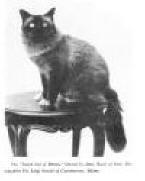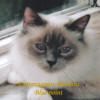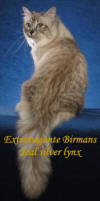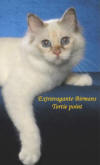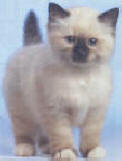
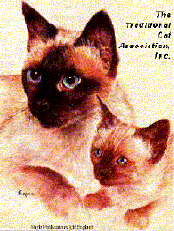 The
Traditional Cat Association,
Inc.©1987®TM
Official Website
The
Traditional Cat Association,
Inc.©1987®TM
Official Website
Founded 1987, by Diana L.
Fineran
|
" Home of the Traditional Cat"© |
|
Our Motto: To Preserve,
Protect, Perpetuate, and Promote Traditional Cats.© |
|
|
|||||||||||||
|
|
|
Gordon described the Temple of Lao-Tsun as “one of the greatest marvels of the East – situated to the East of Lake Incaougji, between Magaoung and Sembo, in an almost desert region of immense peaks and chaotic labyrinths, it offers a barrier of insurmountable walls. Here there still existed in 1898 the last Kittahs (priests), and as a most extraordinary favour I was permitted to see and observe them and their sacred animals. Following the rebellion and the English occupation, at the base of Bhamo (a base very isolated and distant from Mandalay), we had to protect the kittahs against a Brahmin invasion, and we saved them from certain massacre and pillage. Their Lama-kittah received me, and presented me with a plaque representing the Sacred Cat at the feet of a bizarre deity, whose eyes are made of two long sapphires (specimen No. 4108 in my collection at Mildenhall), and after having shown me the sacred cats, in number about a hundred, explained their origin to me.”
“When, with the malevolent moon, the barbarian Siamese Thais came to the mountains of the Sun, Mun-Ha was living in the Temple of Lao-Tsun. Mun-Ha, the most precious among the most precious, for whom the God Song-Hio had woven the beard of gold. This venerable priest had ever lived in rapt contemplation of Tsun-Kyankse’, the goddess with eyes of sapphire, who presided over the transmutation of souls about to receive their dues, whose searching gaze none could evade. Mujn-Ha had an oracle who dictated his decisions, and this was his cat, SINH, whom the kittahs fervently revered.”
The following pictures are courtesy of Laurel Glen Birmans located at www.bellsandbirmans.com Please click on the pictures to enlarge.
 Laurel Glen Victor's Halo |
 5 Month Old Seal Point Kittens |
 Kittens of Champion Samsun Patchouli Of Laurel Glenn |
 Windsor Rose & Winter Rose |
 Violet |
 Woodsox |
The God, Tsun Kyan-Kse was the one who permitted the Kittahs to live again in an animal for the duration of the animals life, before again taking a human body.
“Seated close to his dread master, SINH lived in the contemplation of the goddess. The beautiful animal! His eyes were yellow like gold from the reflection of the metallic beard of Mun-Ha, yellow like the amber body of the goddess with the sapphire eyes.” Sinh was an all white cat as was all of the other 100 temple cats..
“One night at the rising of the moon, the Thais menacingly approached the sacred Temple. (They looted the temple of its riches and murdered the priests) Then, invoking destiny, Mun-Ha died, weighted down by years and anguish. He died in the presence of his goddess, close beside him was his divine cats. The Kittahs lamented their cruel loss. But suddenly, the miracle of immediate transmutation took place. SINH bounded on to the holy Throne. Supported on the head of his stricken master he faced the goddess. And the hair along his spine blanched to a golden hue. His eyes, golden of the gold of the beard woven by the God Song-Hio. His eyes changed to blue, immense, abysmal, and sapphire, like to the eyes of the goddess. His four feet, brown as the earth, his four feet which contacted the venerable skull, whitened to the claws, to the toe-tips, thus purified by the touch of the puissant dead.”
“SINH turned towards the South Door, his imperious gaze, in which could be read an imperative order, possessed of an invincible force the kittahs obeyed. Then they closed on the ancestral enemy the bronze doors of the holy Temple, and passing by their subterranean tunnel they routed the profane invaders.”
“SINH refused all nourishment, and would not quit his Throne. He continued standing erect and facing the goddess-mysterious priest-fixing his steadfast gaze on her eyes of sapphire, partaking of their fire and sweetness.”
“Seven days after the death of Mun-Ha, erect on his
purified feet of white, without lowering an eyelash, he died. Thus was borne
away towards Tsun-Kyankse’ the soul of Mun-Ha. Which was too perfect for
earth. But, for the last time, his look turned slowly towards the South Door.”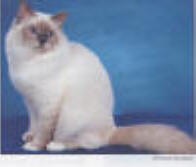
“Seven days after the death of SINH the kittahs assembled before Tsun-Kyankst’ to choose the successor of Mun-Ha. Then-Oh wonder! There came in slow procession the hundred cats of the Temple. Their feet were gloved in white; their snowy hair emitted the reflection of gold, and the topazes of their eyes had changed to sapphires.”
“The kittahs fell prostrate in an attitude of devout fear, and waited. Did they not know that the soul of their masters inhabited the harmonious forms of the sacred animals? And there, solemn and grave, surrounded Legoa-the most youthful of the priests-and so revealed the will of Heaven. When a sacred cat dies in the temple of Lao-Tsun, the soul of a kittah re-enters-to quit no more-the mysterious paradise of Song-Hio, the God of gold. Unhappy are those who even involuntarily hasten the end of these formidable and venerable cats; the most dreadful torments are reserved for them, that the soul in pain may be appeased.”
Gordon remarked, “The Legend is pretty but explains nothing scientifically. One may feel assured that the Burmese Cat is a very ancient race, but it will, I think, be impossible ever to obtain documentary evidence about a race so rare that no breeder or author in the two continents with whom I have corresponded within the last thirty years, has anything more than a sketch of them, and only knows them by the writing of Auguste Pavie and of myself.”
His description of these cats was, “Being much like the Siamese in colouring. They had white toes on all four feet, long hair, and magnificent bushy tails which they usually carried over their back in squirrel fashion. Their eyes were intensely blue, deep and melancholy-gentle when at rest, but wild and fiery if angered.”
The Traditional Birman was unknown outside of its place of origin at that time. Then the exodus of the breed from Burma becomes murky with folklore. Supposedly in 1919 a male and female Traditional Birman from the Lao-Tsun temple were surreptitiously taken from Burma and given to two Englishmen living in France, as thanks for their help in defending the temple in the invasion and helping the priests and their sacred cats to escape to Tibet. They were Major Gordon Russell, a British officer and Mr. August Pavie, an explorer. Another account says they were only given to Mr. Russell Mr. Russell’s writing doesn’t suggest such an event, however. Another variation tells about Mr. Vanderbilt, an American millionaire traveling in the Far East, who obtained two cats, “for a price of gold” which were smuggled from the temple by an unfaithful servant of the priests. Supposedly Mr. Vanderbilt sent those cats to Mme. Thadde Hadisch in France. It is mutually accepted that there was a pair of Traditional Birmans sent to France. The long ocean voyage was so strenuous the male cat, Madalpour, didn’t survive the conditions. The pregnant female, Sita, gratefully did survive the voyage and produced kittens in France. One of their kittens, a female named Poupee was bred to a cat of a different breed, perhaps a Traditional Siamese to perpetuate the breed. So it was that from this tiny beginning the Traditional Birman was begun in Europe.
Some say neither of these stories is true and that the breed was created in France by crossing Siamese with Bi-colored Persians!
The breed was recognized as a separate breed by the French in 1925. Tragedy struck when WW II left only two Traditional Birmans in Europe, who were named “Orloff” and “Zenia de Kaabaa”! Out crossing was implemented to bring the breed back, with the requirement of at least 5 generations of pure breeding after out crossing was done before the breed was fully accredited. Other breeds were recruited as outcrosses, possibly Traditional Persians (Doll Face) and more Traditional Siamese. By 1955 they were re-established and recognized as purebreds .
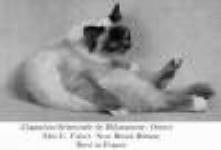 Those who were the earliest breeders of Traditional Birmans
in France were Anne Marie Moulin, breeder of Orlamonde de Khlaramour, Opale de
Khlaramour and Nadine de Khlaramour, Yvonne Drosier, breeder of Osaka de Lugh,
Madame Simone Poirier, owner of Nouky de Mon Reve, Mme. Marcelle Adams of
Madalpour Cattery and Monsieur Baudoion-Crevosier of da Kaabaa Cattery.
Those who were the earliest breeders of Traditional Birmans
in France were Anne Marie Moulin, breeder of Orlamonde de Khlaramour, Opale de
Khlaramour and Nadine de Khlaramour, Yvonne Drosier, breeder of Osaka de Lugh,
Madame Simone Poirier, owner of Nouky de Mon Reve, Mme. Marcelle Adams of
Madalpour Cattery and Monsieur Baudoion-Crevosier of da Kaabaa Cattery.
Mrs. Margaret Richards and Mrs. Elsie Fisher imported three cats from the French Catteries in 1965. These cats were the foundation breeding stock for their Praha and Paranjoti catteries in England.
The breed expanded around Europe. Many trace their pedigrees to England and France. They were accepted as a distinct breed in England in 1966 and in the U.S. in 1967.
A short list of the early breeders of Traditional Birmans in the U.S. begins in 1959, when the first recorded importation was accomplished by Dr. and Mrs. John Seipel. Mrs. Gertrude Griswold in Tacoma, Washington received two Seal Points as gifts in 1961 and they were said to be “Tibetan temple kittens” with the Traditional Birman’s identical coloring, pattern and accompanying legends. At first Mrs. Griswold’s cattery name was “Clover Creek”, but was later changed to”Griswold”. She wrote to breeders in France, exchanged kittens with them and established her cattery. One of her cats was “Korrigan of Clover Creek” who sired one of the first U.S. Champions.
Mrs. Verner Clum of “Gaylands Cattery” was another early breeder.
Cats purchased from Mrs. Griswold, Mrs. Clum and from Mrs. Fisher’s Praha Cattery formed the beginnings of Frances Price’s, “Tai Ming Cattery”. Her breeding program was successful over a period of 30 years.
Rindy’s Haven Cattery, owned by Ed and Harriet Rindfleisch, began after they imported their first Traditional Birman in 1970 from England.
Others were Tarazed Cattery, owned by Melanie Kreidi, Celtic Cattery, owned by Joseph and Maureen Escalette, and Oxdowne Cattery, owned by Walter and Betty Cowles.
The gloving gene is what governs the white feet. This gene is not completely understood, yet geneticists believe it is recessive and unrelated to the more common dominant “piebald” or white spotted factor gene. Both parents must carry the recessive gloving gene to produce kittens with white gloves. The placement of the white is nearly impossible to control, causing unpredictability in getting the right amount of white on each paw. The white gloving gene has incomplete dominance, which makes it rather rare to get the perfect show marked kitten.
Traditional Birman’s are born white with color beginning to appear slowly. The white on the front feet, called “gloves” and the white on the back feet, called “laces” takes time to appear.
What is their PERSONALITY?
The Traditional Birman is a marvelously active, playful, gentle, loving, well mannered, affectionate, devoted but quiet and unobtrusive companion. They are very people oriented. Their soft, unobtrusive voices sound somewhat like a dove’s cooing. They enjoy being talked too and will reciprocate with melodious, soothing meows. A good game of fetch or hide and seek easily goes on with their preferred people. A high intelligence is evident because they quickly learn their names. Some call them the middle of the road breed, because they are not as active as a shorthair, yet they are not as laid back as some longhairs. They can be a lay beside you cat, a lay in your lap cat or a lay on you cat. Gently they let their people know when they crave attention. Once received, they go on their way until attention is needed again.
The Traditional Birman is easy to handle, care for and live with. They don’t like being the only animal in the home. Instead their tolerant, easy going natures allow them to enjoy the company of another Traditional Birman, other cats of different breeds, children or a dog.
Generally Traditional Birmans are not fussy eaters are healthy and live quite long lives. Some live 15 to 20 or more years. Since their coat is long, but not inclined to mat, a brief daily combing with a steel comb will keep the Traditional Birman looking its best.
|
The Traditional Cat Association, Inc.©1987®TM ALL RIGHTS RESERVED © by John & Diana Fineran - Aug 1999- 2025 No portion of this website or any information contained within it may be copied, or in any way distributed, without the expressed written permission of John or Diana Fineran - No exceptions. |
